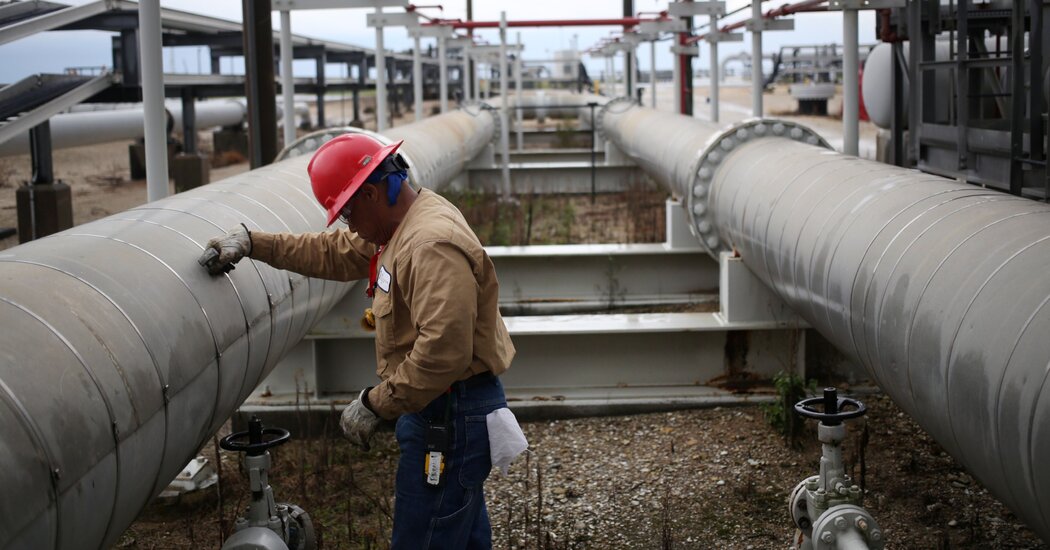
As gasoline prices and inflationary pressures have climbed in recent weeks, calls have been growing in Congress for the Biden administration to tap into the nation’s Strategic Petroleum Reserve.
The Senate majority leader, Chuck Schumer, added his voice over the weekend. “We need immediate relief at the gas pump, and the place to look is the Strategic Petroleum Reserve,” Mr. Schumer, a New York Democrat, said at a news conference.
Energy Secretary Jennifer M. Granholm has said such a release is one measure that the administration is considering to calm energy markets, along with urging Saudi Arabia and other foreign producers to lift petroleum output.
People who support such a release have said a sale from the reserve with oil prices over $80 a barrel would not only increase supplies and reduce prices at the pump but also produce billions of dollars of revenue for the federal government.
What is the Strategic Petroleum Reserve?
Storing roughly 620 million barrels of various grades of crude oil in underground caverns in four locations in Texas and Louisiana, the Strategic Petroleum Reserve holds the largest emergency supply in the world. It is capable of satisfying the nation’s consumption needs for about a month in the unlikely event that all imports and domestic production were halted.
Established after the 1973-74 oil embargo by Arab members of the Organization of the Petroleum Exporting Countries, it has been used in only a few emergencies, including the buildup to the Persian Gulf war in 1991 and the aftermath of Hurricane Katrina in 2005, when much of the Gulf of Mexico oil infrastructure was damaged. More frequently, it has been used to exchange or lend oil to refineries when ship channels were blocked by barge accidents or storms.
What is the argument for releasing oil?
With the world’s economy and shipping lanes contorted by the pandemic, the United States faces inflation pressures not experienced in decades. And now that the United States is a major oil producer, it does not need to keep the reserve as full as in the days when the country was far more dependent on foreign oil.
“High gasoline prices have placed an undue burden on families and small businesses trying to make ends meet,” according to a letter sent by 11 Democratic senators to President Biden last week, “and have proven especially burdensome as our constituents continue to recover from the economic fallout of the Covid-19 pandemic.”
A release would recalibrate the supply-demand equation, alleviating oil market tightness. Even a temporary reduction in domestic oil, gasoline and diesel prices would relieve inflationary pressures on food and other goods that are trucked around the country.
With oil prices more than doubling since the economic collapse that accompanied the harshest months of the pandemic, the average price for a gallon of regular gasoline in the United States has risen to $3.42 on Monday from $2.13 a year ago, according to AAA.
Supplies globally are tight because OPEC members have kept a lid on production to support prices. American producers have also been cautious, in part because investors are demanding that they focus on reducing debt and raising dividends rather than increasing production only to oversupply the market and reduce prices again.
What is the argument against a release?
Releases should be reserved for true emergencies. The reserve was established and designed to address emergency disruptions from wars and storms, not the periodic increase in prices at the pump. When supplies are tight, prices naturally rise, and usually companies respond by producing more to solve the price issue at least eventually.
Would a release be effective?
Most experts believe a release would lower prices modestly, at least for a short time.
How much depends on how much is released and whether such action is coordinated with allies that could also release reserves, like Japan and Germany. A release of, say, 30 million barrels would have no more than a temporary impact since oil prices are set globally and world consumption averages roughly 100 million barrels a day.
Understand the Supply Chain Crisis
“A release of S.P.R. volumes, which are mostly held in crude oil and not oil products like gasoline, would offer a reprieve to gasoline prices, but the impact would likely be mild and short-lived,” said Louise Dickson, senior oil markets analyst at Rystad Energy, a consultancy.
Oil prices have eased in recent days, perhaps in part because the threat of dipping into the strategic reserve is taken seriously by petroleum traders. The average price of a gallon of regular gasoline has fallen by a penny over the last week.
“The market is again focusing on the U.S., and how the Biden administration will act now that political pressure is ramping up,” Ms. Dickson said.
But it is not the only reason. The dollar’s recent strengthening has lowered the oil price because it takes fewer dollars to buy a barrel of oil. American shale oil producers have been adding to their rigs in service, which should bring more supplies on the market in the coming months. Also, a new coronavirus wave has hit parts of Europe, threatening to slow down the continent’s economic recovery.
Could a release lower home heating prices?
Maybe in some places. Most homes use electricity or natural gas for heating. But about five million homes still use heating oil, mostly in the Northeast. A release from the strategic reserve could help modestly, but any impact would have to wait until late in the winter for the oil to be processed by refiners and shipped.



